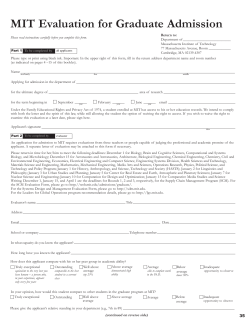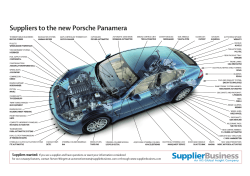
Trans-Atlantic Workshop
Trans-Atlantic Workshop on Rare Earth Elements and Other Critical Materials for a Clean Energy Future Carbon fibers as raw material for light weight systems in wind energy and automotive applications … Availability and challenges for the future Dr. Michael Heine MIT Cambridge/Massachusetts, Dec. 3, 2010 Agenda • Fundamental global challenges • Competitive advantages of carbon fibers • Carbon fibers applications – Wind energy – Automotive • Carbon fiber market demand • Consequences • Future prospects Trans-Atlantic Workshop MIT Cambrige Page 2 / Heine Fundamental global challenges foster the future economy Key challenges Changed economic environment General approach Sustainable solutions Climate change Energy / raw materials availability “Towards an ecologically sensitive world” Energy efficiency Alternative energies Light weight Carbon fibers contributes to all three sustainable solutions Trans-Atlantic Workshop MIT Cambrige Page 3 / Heine The competitive advantages of carbon fibers Energy efficiency Alternative energies Light weight Sustainable solutions 7,9 Density (kg/l) 2,7 1,6 Steel Aluminium CFRP No other material is lighter … or stronger and stiffer Trans-Atlantic Workshop MIT Cambrige Page 4 / Heine Carbon fibers for wind energy and automotive Energy efficiency Alternative energies Wind energy Light weight Sustainable solutions Automotive Audi R8 General technology trends: General technology trends: • On shore to off shore • Fuel efficient cars • Increase of rotor-blade size • Alternate fuels (CNG, LPG, E-10) • Rotor-blades with higher strength to weight ratios • Hybrid propulsion • Integrated systems such as wind-diesel, windSPV, wind-battery etc. Trans-Atlantic Workshop MIT Cambrige Page 5 / Heine • Plug in electrical vehicles Wind energy: Carbon fibers for „Large Rotor-Blade Sizes“ approx. 0.7 mt CFRP / rotor blade approx. 2.1 mt CFRP / wind mill main spar flange CFRP main spar web Nominal power Rotor diameter Axial height Annual energy harvest Trans-Atlantic Workshop MIT Cambrige Page 6 / Heine sandwich shell Automotive: Carbon fibers for „Light Weight Car Design“ Electrified engine, transmission and storage system leads to an higher total mass „Compensation of electrical system mass by reduction of structural mass “ benzine /diesel 170 g/km electricity conventional 90 g/km electricity wind energy 3 g/km World Wind Energy Report 2009 Trans-Atlantic Workshop MIT Cambrige Page 7 / Heine CF market demand [kt] Main drivers: Energy efficiency, renewable energy and light-weight systems 143 10 Sport 24 Aerospace 109 Industry 87 38 8 8 38 33 6 8 7 9 77 9 66 9 55 18 9 45 17 8 15 7 11 13 22 19 22 27 2008 2009 2010 2011 8 Trans-Atlantic Workshop MIT Cambrige 34 2012 42 2013 51 60 ca. 15 % automotive ca. 30 % wind 2014 2015 2020 Investment in new carbon fibre capacities to follow the demand sports 140.000 t/a aerospace Edison carbon filament bulb other industrial applic. 100.000 t/a 60.000 t/a automotive PAN 1880 1900 1920 1940 1960 20.000 t/a wind 1980 2000 2020 2040 80 years 1000 to/a = 15 m€ 1500 m€ 900 m€ 300 m€ 2010 9 Trans-Atlantic Workshop MIT Cambrige 2020 Investment in R&D of process technology, recycling and modelling Process chain carbon composites PAN precursor Carbon fiber CF Fabrics Preform s prepreg s CF reinforc ed plastics CF reinforc ed carbon CF reinforc edSiC Development of enhanced process technology Polymer chemistry High temp. technology Textile technology Engineering components = additional CF capacities Recycling / Re-Use of CF x Simulation / Modelling Trans-Atlantic Workshop MIT Cambrige Page 10 / Heine x x x Future prospects: Green energy for carbon fibre manufacturing JV SGL-BMW Moses Lake, WA http://www.energie-visions.de/wasserkraft.html Process chain carbon composites Stabilisation & carbonisation of PAN Trans-Atlantic Workshop MIT Cambrige Page 11 / Heine Future prospects: Renewable raw material for carbon fibre production p.e. Cellulose Crude oil based Trans-Atlantic Workshop MIT Cambrige Page 12 / Heine p.e. Lignin Trans-Atlantic Workshop MIT Cambrige Page 13 / Heine
© Copyright 2025










